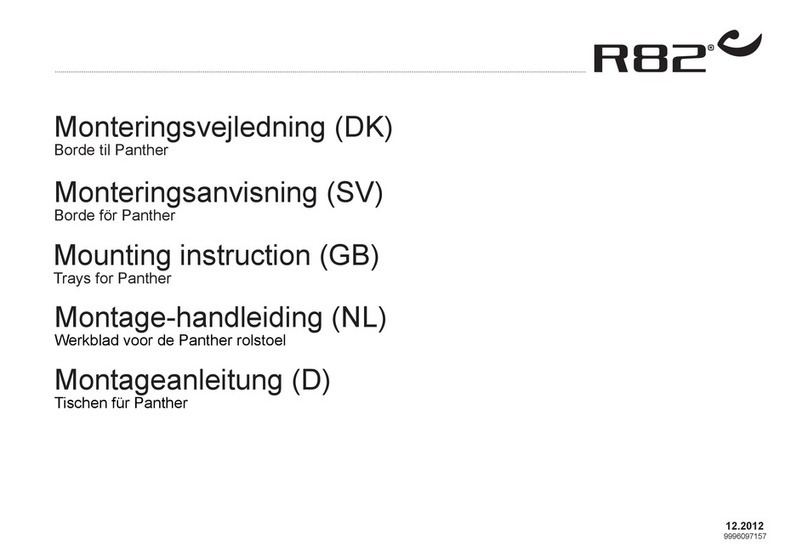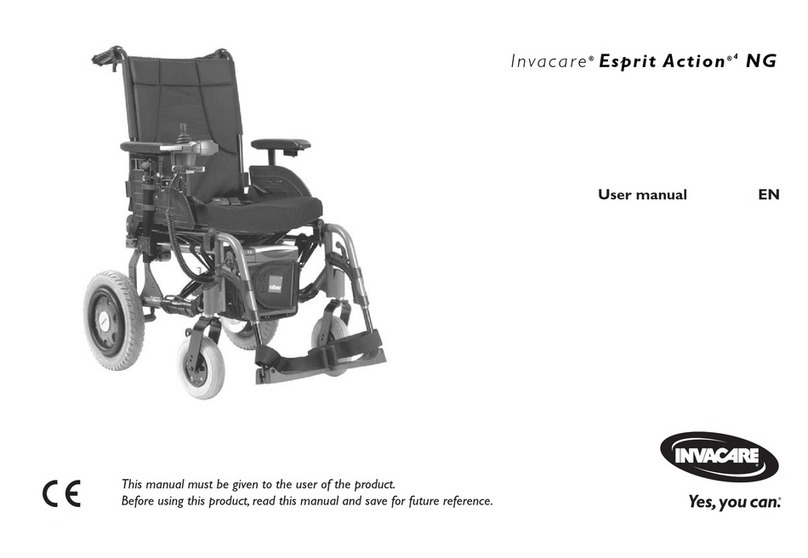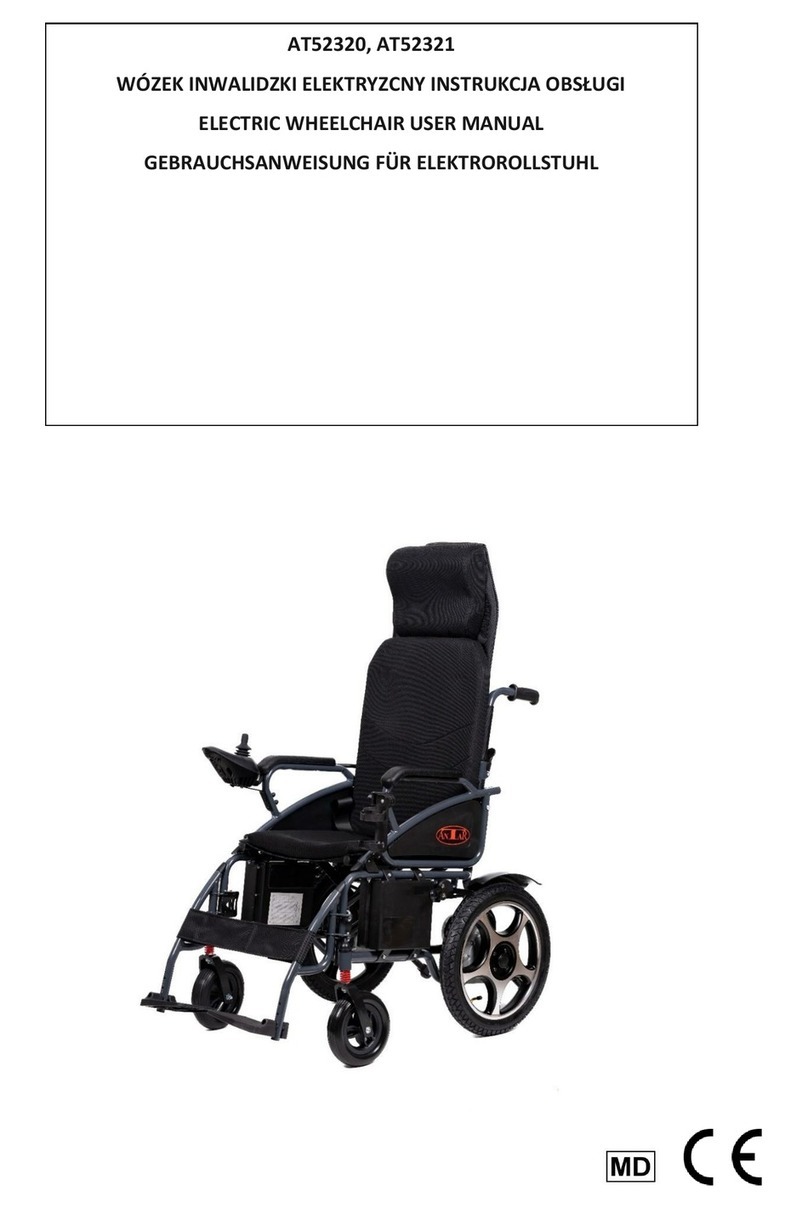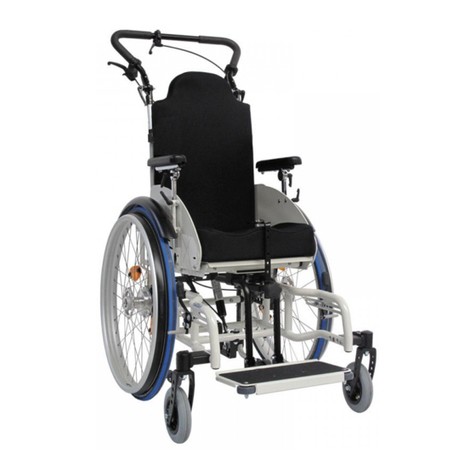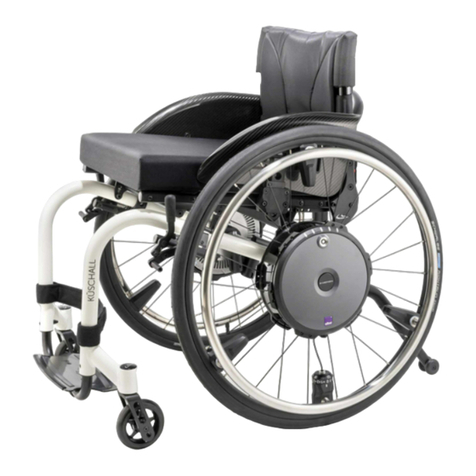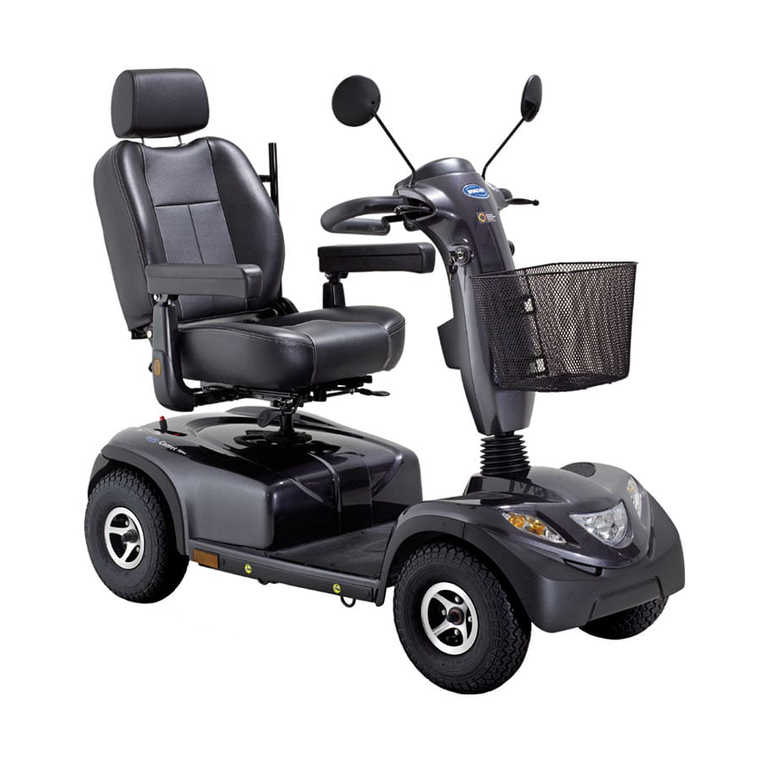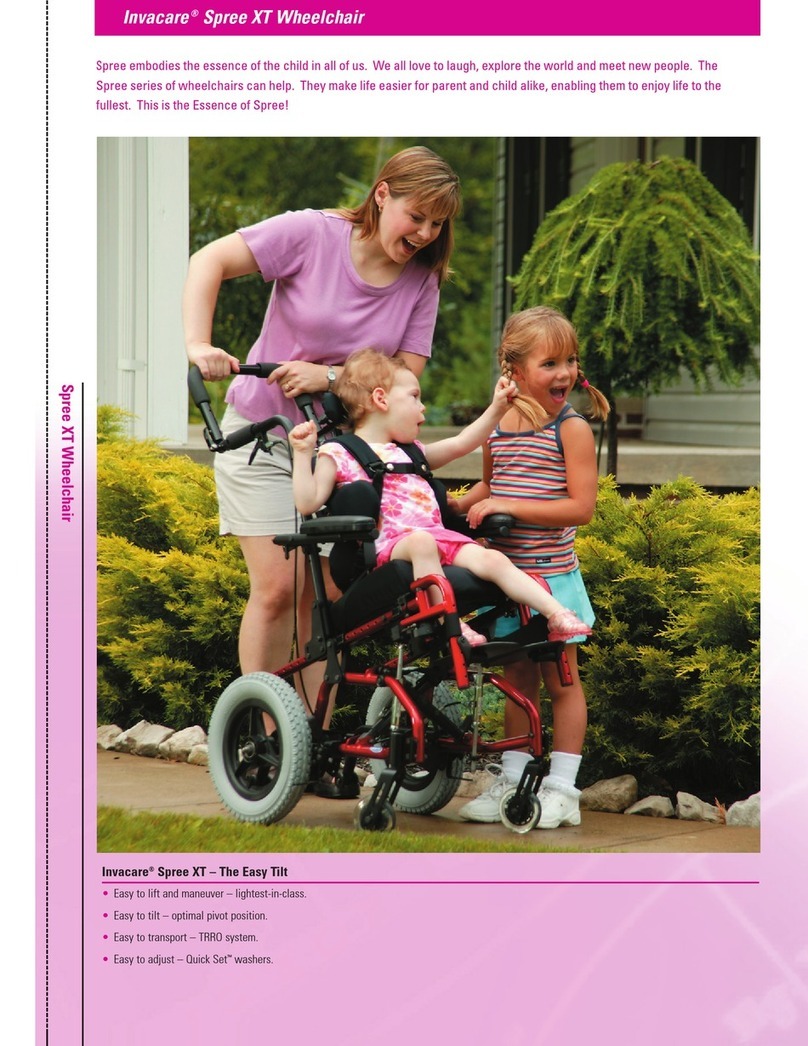GILANI ENGINEERING D39 Phoenix User manual

User’s Manual
D39
PHOENIX

INTRODUCTION
Thank you for choosing the D39 Power Wheelchair for your portable wheelchair trans-
portation needs. It is important to read through this manual before operating your D39
Power Wheelchair to become familiar with its features as well as its limitations and safety
information.
You will find the operation and care of your D39 Power Wheelchair simple and easy.
Disclaimer:
As part of our ongoing product improvement initiative, we reserve the right to change
specifications and design without notice. As a result, there may be minor differences be-
tween your D39 Power wheelchair and accessories and the photos, illustration and instruc-
tion in this manual.
Dear Users,
JBH and partners cannot be held responsible for personal injury or property
damage resulting from the unsafe or improper operation or maintenance of
D39 Power wheelchair.
We strongly believe that the wheelchair would bring you more convenient and reach the
goal of free life to you. If you discover a problem, contact your authorized local Dealer or
Distributor for assistance, alternatively direct contact with manufacturer with the following
Contact Information.
Recommendation
Please pay attention to “Warning” in the manual is to protect you from any injury.
Unable to follow “Notification” in this manual may result in damage the wheelchair.
www.jbhmedical.com
www.jbhmedical.com
We

CONTENTS
.........................................................................................
Specification Diagram
Specifications
....................................................................
Product Related Explanation
Product Features
................................................................................................
Install Setup .............................................................................................................
Controller
...........................................................................................................
.......................................................................................
Charging Batteries
..................................................................................................................
Free Wheel Mode
Transporting D39
...............................................................................................
Trouble Shooting And Maintenance
Electrical Wiring Diagram
Electromagnetic Interference & Compatibility
...................................................................................................
Diagnostics
...................................................................................................
.....................................................................................................................
............................................................
..............................................................................................................
.................................................................................
Warranty
.......................................
Warranty Card........................................................................................................
5
.......................................................................................
6
...............................................................................................
.................................................................................
7
8
3-4
9-17
18-20
21
22
23-26
27-31
31
32
43-47
48
......................................................................................... 1-2
Security Guidance
Safe Use Guideline
Battery Setup
Folding And Unfolding
Symbol Definition
34-38
33
42
39-41
www.jbhmedical.com

1
SYMBOL DEFINITION
Warning
Beware of potential hazard
Type B applied part
Refer to instructions for
use - Mandatory
Failure to read the instruc-
tions for use could intro-
duce a hazard
Refer to instructions for
use - Recommended
Failure to read the instruc-
tions for use could intro-
duce a hazard
IPX
IP Water proof grade
Type BF applied part
Medical device
Importer
Distributor
Country of Manufacture
=Radio frequency fields
beyond this point may
exceed FCC general
public exposure limit
Name and Address of
European Union
Representative
Unique Device
Identification
Model Number
Attention, see
instruction for use
Date of manufacture
Manufacturer Product fulfill
WEEE directive
Serial number
Batch number
CE mark
Use until year &
month (Expiration date)
Don’t use when packing
damaged
EC REP
UKCA mark
www.jbhmedical.com

2
Type 2 device
Protect from heat and ra-
dioactive sources
Store in clean & dry place
protected from rain, snow,
ice, salt and water.
Humidity limitation Temperature limitation
Avoid contacting with rain,
snow, ice, salt and keep-
ing in water, keep under
clean and dry ambience.
Do not adapt battery which
is with different capacity
and wrong model number.
With potential explosion
100~240VAC, 50~60 Hz
Never combine use long
time used battery with new
battery at the same time,
always change batteries in
brand new condition.
Disposal and recycling only
authorized recycling com-
panies can recycle parts of
this mobility wheelchair
Package Number
Foot Switch
Power
500VA
Frequency
DC output +29.4V 2.0 A
Danger of explosion
Keep dry
CF application part
Volume control
Fuse
Equipotential
Switch
PCTB
Do use cel phone, remote
speakers, note book com-
puter or other wireless
ejecting device while op-
erating the unit.
Easy to be crashed, crash-
ing spot
Keep away other metal re-
lated items or tools away
from the negative and posi-
tive terminal end to avoid
any short cut or electricity
shock from happening.
The product has passed
electromagnetic test of
20 V/M.
Implication of flammable
material. Do not expose
under fire, fire sparkles
and other heat sources
conditions. Never trans-
port batteries along with
torch easy explosive
items or flammable mate-
rials.
Battery contains an-
ti-corossion chemical
substance.
www.jbhmedical.com

SECURITY GUIDANCE
3
Weight limitations
The user must perform all of the procedures in this manual.
This product is suitable for users with age between 18 to 75 years old.
Do not drive on public highway.
No over cross any gap which is over 100 mm (3.94") in width.
Never try to overpass obstacle which is over 40 mm (1.57") in height.
Wheelchair is suitable for both outdoor and indoor use, hospital, senior center,
family or similar circumstances use only.
The suitable environment of using electric wheelchair:
Temperature -10 ~+50℃, Atmospheric Pressure 860 ~1060hPa, Humidity
10% ~93%.
Power Source Condition:
Charging Voltage AC (100-240)V ± 10%, 50 ± 1Hz, Battery Voltage DC 24V
(+5%, -10%), Power of Motor ≥250W environmental conditions that might be
harmful to the wheelchair (e.g. inclines greater than 12 degrees, rain, snow,
ice, etc.), such as temperature and humidity.
Operate wheelchair after it is under unfolded condition and only allow one
person on wheelchair all time.
1.
2.
3.
4.
5.
6.
7.
8.
9.
WARNING !
WARNING !
WARNING !
We are not responsible for any damage and inquiry cause due to
over weight.
Not to drive on dangerous slopes.
Not to drive backwards when going up and down a hill. Max grad
ability is uphill 8°.
The wheelchair is tested with simulation of human model at 300kgs (661.4 lb)
load capacity.
Your wheelchair is rated for a maximum weight capacity. Please refer to the
product specifications table for this limit. Keep in mind that the maximum
weight capacity includes the combined weight of the user and any accessories
mounted to the wheelchair. Stay within the specified weight capacity of your
wheelchair. Exceeding the weight capacity voids your warranty. We will not be
held responsible for injuries and/or property damage resulting from failure to
observe weight limitations.
1.
2.
www.jbhmedical.com

4
Statement
Instructions
The wheelchair (Model D39) has a base with alumini-
um alloy frame, two front wheels, two rear wheels, a
seat, an adjustable steering column, a tiller console, an
electric motor, an electromagnetic brake, 2 recharge-
able Lithium-Ion Batteries with an off-board charger.
The movement of the wheelchair is controlled by the
rider who operates the throttle lever, speed control dial
and handle on the tiller console. The device is installed
with an electromagnetic brake that will engage auto-
matically when the wheelchair is not in use and the
brake cannot be used manually. The wheelchair only
can be operated on the flat road.
Indications for use:
It is a motor driven, indoor and outdoor transportation vehicle with the intend-
ed use to provide mobility to a disabled or elderly person limited to a seated
position.
Please read the following statement.
Please read this manual carefully and understand everything clearly before
using the electric wheelchair for the first time.
1.
2.
Improper use will cause death or serious injury.
Improper use will cause damage of wheelchair.
Comply with the manual to keep wheelchair in good condition.
DO NOT make sharp turns at high speed or on inclines or reverse direction
abruptly.
DO NOT utilize brake release / freewheeling option on any incline without as-
sistance to control motion.
To avoid danger of suffocation, keep all the plastic bag in the package away
from babies and children. Do not use the plastic bag in cribs, beds, carriages
or playpens. The plastic bag is not a toy.
1.
2.
3.
4.
5.
6.
Please do not use the wheelchair in any unclear cases, otherwise, the product
may be damaged or people may get hurt. If you have questions, please con-
tact us.
Please pay attention to the warning and cautions in this manual. We are not
responsible for any injury and damage caused by wrong use of this product
and neglect of the warnings and cautions.
1.
2.
www.jbhmedical.com

5
PRODUCT FEATURES
Based on Electric Shock Proof Classification: Classified as internal power type
device during operation, it is type 2 device while it comes to charging.
Based on classification of Electric Shock Proof: It belongs to B type applicable
section.
Based on classification of liquidity proof: IPX 4
Based on the the safety classification of using combustible anesthetic gas mixed
with air, Oxigen, or flammable anesthetic gas mixed with nitrous oxide: Not
AP/APG type.
Classification of running mode: Continuously-running mode.
Rated Voltage and Frequency: Internal power DC 24, Charger AC 220 V / 50 Hz.
There is no applicable protection of defibrillation discharge effect.
There is no signal input .
The product is not belong to eternal installation.
For electrical insulation diagram, please refer to photo 1.
1.
2.
3.
4.
5.
6.
7.
8.
9.
AC 220 Charger
Battery
Product features
Controller
Motor
Driving Device
AP
Photo 1
10.
www.jbhmedical.com

6
PRODUCT RELATED EXPLANATION
Intended user, with visual weakness, intellectual impairment or
neck disease, who is unable to observe environment on the back,
should be operated by others. Anyone with paraplegia below the
chest, osteoporosis or hypochondriasis is prohibited to use the
product.
Model no.
Year
Month
Serial No.
Please refer to QR code on frame
【Frame No.】 D39-2018-05-001
【Contraindications】
【Eternal Identification Mark】
xxxxxxxxxxxx
【 Label of the Wheelchair 】
The product is for people with inconvenience of having ability to walk fully or
having or with disabilities (excluding obesity).
【Intend Use】
www.jbhmedical.com

SPECIFICATIONS
7
Seat back/
Push handle
Backrest cushion
with storage bag
Storage bag
Rear wheel
Fender
Armrest
Controller
Controller knob
Seat cushion
Footrest
Battery
Front wheel Anti-till wheel
Gross Weight (With Export Packing)
Model D39
Aluminum Alloy
Rear Drive
Intelligent Electromagnetic Brake
Material
Loading Capacity
Motor
Driving Range
Front Wheels
Rear Wheels
Climbing Slope
Charging Time
Width Between Armrest
Seat Width
Seat Depth
Seat Height
Turning Radius
Drive Model
Braking System
Max Speed
Battery
6~8 hours
Max 8°
Fold Size (L * W * H) (mm/inch)
250W × 2 pcs brushless motors
24V 10AH × 2 pcs lithium battery
6 km/h (3.7mph)
35 km (21.7 miles)
12.5" PU solid wheels
900 mm (35.4")
Unfold Size (L * W * H) (mm/inch)
Net Weight (Without Battery)
Net Weight (Finished Product)
8.5" PU solid wheels
500 mm (19.7")
500 mm (19.7")
560 mm (22")
600 mm (23.6")
40 kgs (88.2 lbs)
44 kgs (97 lbs)
51 kgs (112.4 lbs)
1200 × 660 × 1100 mm (47.2"×26"×43.3")
660 × 360 × 890 mm (26"×14.2"×35")
300 kgs (661.4 lbs)
www.jbhmedical.com

SPECIFICATION DIAGRAM
8
660 mm (26")
500 mm (19.7")
1200 mm (47.2")
12.5" 8.5"
1100 mm (43.3")
560 mm
(22")
500 mm
(19.7"
)
360 mm
(14.2")
890 mm
(35")
www.jbhmedical.com

9
SAFE USE GUIDELINE
Carefully read through the instructions, or receiving training and guided by profes-
sional techinician or nusing staff who is familiar with the product.
Always have full understanding and feel of electric wheelchair prior to start up
and operate the wheelchair.
Always with help by nurse to practice forwarding, bakcarding, obstacle overcom-
ing and so on, until familiar the operations independently, proficiently and safely.
Make sure fully aware of safety if you would like to try a new action.
Have a full realization of the area where you would like go with electric wheel-
chair, keep away and hazards.
Keep metal objects away from positive and negative terminals of battery to
avoid electric shock adn circuit short cut.
For uers
1.
2.
3.
4.
5.
The power switch must turned off and the freewheel mode lever each on left and
right motor is switched to manual mode before pushing the wheelchair by hand,
once the levers are switched to manual mode that motors are not work.
From behind to push backrest frame while choosing manual push the electric
wheelchair. It is safer and it keeps reliable force point to prevent wheelchair from
overturning. Make sure the folding and unfolding buckle is securely locked.
Keep cooperating with user all time, particularly prior to each action inform user
your intention and clearly give your reasons.
To protect the back of user from injury while passing through obstacle, user
should have kept with right dynamic body posture. Bend your knees slightly in
order to keep you back upright.
Remind mind user of leaning body agaist backrest while you are about to lift up
the back of electric wheelchair.
Never directly go up and down stages or stairs, there is potential danger of falling
off or roll over when turning a a corner, climbing up and down.
Do not go uphill or dowhill under manual mode condition of electric wheelchair
that could lead to the risk of slipping.
For caregivers
1.
2.
3.
4.
5.
6.
7.
www.jbhmedical.com

10
Inspect and adjust the installation of joystick every six months, as ften as it is
necessary.
Contact with your local dealer or distributor if the control panent of joystick con-
troller abnormal and its operational malfunction.
Note: Adjust the installed position of joystick controller (as photo 2) to pro-
tect from any risk of bump or falling down.
Precautions on controller
1.
2.
Power off the electric wheelchair while it is stopped, even it is a short time stop-
ping (Refer to photo 3). This will prevent any accidental touch of joystick by
anyone for the accidental interference on electromagnetic system affect normal
use of electric wheelchair.
Make sure any helper (say shop assistant)is fully understand the joystick func-
tion, there no any accidental touch to prevent sudden move wheich is unexpect-
ed.
1.
2.
Precautions when electric wheelchair is under not
moving status
Photo 2
Photo 3
Power off
www.jbhmedical.com

11
Avoid malfunction of electric wheelchairs:
This electric wheelchair is not suitable for use or kept under the environment of
heavy rain, snow or ice. Contact with water or excessive humidity will lead to
electrical failure.
Operational environment
1.
The electric wheelchair is only suitable for roads with concrete, asphalt and
indoor floor surfaces.
Do not drive on sandy soil, loose soil or rough and rugged terrain to avoid any
damage of wheels, bearings, shafts or motors, for causing loosening of parts.
Suitable surfaces
1.
2.
When it is unable to avoid operating the electric wheelchair onto wet or smooth
ground, please be careful and keep at very slow speed.
2.
Do not place or keep the electric wheelchair under direct impact of water (such
as heavy rain) or in a very humid environment.
Please do not use this electric wheelchair while in bathing, sauna and swimming.
Please do not use this electric wheelchair near water sources (such as rivers,
lakes or oceans).
Please ensure that the battery charging cover is closed.
If the joystick is damaged, please replace the joystick device.
Ensure that all electrical connectors are secured and free of looseness.
It is forbidden to wash this electric wheelchair with water. If the electric wheel-
chair is soaked, please remove the battery and dry the electric wheelchair as
soon as possible. Dry immediately after the electric wheelchair is determined,
Insert it into the battery holder for reuse.
One or two main wheels apear to have lose traction, Stop the electric wheel-
chair immediately to avoid out of control or falling down.
Any snow, ice, water or oil film on any slope or ramp, please do not drive
when come across these situations.
With doubting and can't confirm the safety, please always ask for helping.
www.jbhmedical.com

12
Most countries and regions are illegal for powered wheelchairs to drive on
motor vehicle lanes. It is dangerous for electric wheelchairs to drive on roads
or parking lots.
When dirve at night or in darkness, reflective stickers attached on electric wheel-
chair are helpful (Refer to photo 4). For safety concern user can also wear a gar-
ment with Reflective material.
When come across with other vehicles, make sure the drivers of vehicles notice
you easily. Have eye contact with the driver before you continue. Communicate
and allow the driver understand your intention until you are convinced that it is
safe.
Driving on road
1.
2.
Do not to drive electric wheelchair through transportation, such as buses, sub-
ways, trains, planes and ships.
If you must drive an electric wheelchair, you should be accompanied by someone
to find a reliable place to park, fasten your seat belt and turn off the power supply
of the electric wheelchair.
If the user drives the electric wheelchair alone, it is necessary to find a place
where the wheels or the whole electric wheelchair can be fixed and parked, so
as to avoid injury of sudden braking or traffic accidents.
Don't keep the electric wheelchair in the front of any vehicle, as a result of inter-
fering with driving of vehicle driver.
To get on and off bus, if necessary to lift the user together with the electric wheel-
chair, please hold the edge of the seat cushion frame, Never hold the armrest or
the rear backrest frame.
Safety tips for riding motorized vehicles
1.
2.
3.
4.
5.
Photo 4
www.jbhmedical.com

13
The electric wheelchair should be kept in balance and at stability to center
gravity while diriving to avoid overturning during the process of forward and
backward. The balance to center gravity is affected by the following factors:
The seat height and angle.
Dynamic body position, posture or weight distribution of user.
The angle of ramp or slope.
Change load and weight distribution of electric wheelchairs by applying backpack
or other object.
Balance on driving
1.
2.
3.
4.
If modify or adjust this electric wheelchair required, please consult with your dealer
in advance, a modification plan should be authorized by the manufacturer in writing.
The modification of electric wheelchair could have additional adjustment to correct
the center of gravity. When electric wheelchair has been modified, be especially
careful to familiar with the balance point of the electric wheelchair and master the
ways to avoid falling or overturning.
When you sit in an electric wheelchair and dressing colth, your body will rotate. In
order to make the electric wheelchair more stable, the front caster should be adjust-
ed to the forward position.
Recommended cloth dressing on electric wheelchair
www.jbhmedical.com

14
Precautions for getting on/off electric wheelchairs
When it is ready to seat on the electric wheelchair, please make sure to turn off
the power first. If you touch the joystick, it may cause electricity. The wheelchair
moves unexpectedly due to unexpected mistake touching.
Learn safest way to move your body from your health care professionals, the way
to position your body and properlyupport yourself in the process of moving.
Ask for help you until you before you can safely get on and off the electric wheel-
chair alone.
1.
2.
3.
The correct way to get on/off an electric wheelchair
Be careful every time move yourself, have a support point that is not lower
than the seat cushion surface.
Keep electric wheelchair as close as possible where you want to sit. If possible,
use a conversion board.
Rotate the front casters as forward as possible.
1.
2.
Don't stand on the foot pedal to move your body, it may lead to harm.
Make sure your feet are not caught or caught between the gaps of the
pedals.
Ensure that it is not blocked or interfered by handrails ( Refer to photo 5 ).
Move to the seat as soon as possible, it reduces the risk of missing seat and
falling.
Photo 5
www.jbhmedical.com

15
While change your body center of gravity in-
cluding raising your body sideways or leaving
seat, please don't lean beyong the range of seat
cushion of the electric wheelchair.
Move forward in your seat, please don't lean
over or have inclination (Refer to photo 6),
always keep your hip attach to backrest.
Don't keep hands reluctantly to grab things
which are far away, in case lose body balance
and fall.
Under no circumstances should you try to pick it
up articles from between your knees or in front
of your body (Refer to photo 6).
Don't put pressure on the pedals when your
body is extended, in case of falling off caused
by falling over.
Don't lean against the top of the seat back to
prevent from falling and damaging the back.
Precaustions of hand extending, body leaning and body
strechting while seat on wheelchair
1.
2.
3.
4.
5.
6.
Body part extending, leaning and streching will affect the balance of center
gravity of the electric wheelchair, which may cause you to fall or turn over
with improper operation. Follow the key points below to reduce the risk of
physical injury and damage:
If you move your electric wheelchair beyond the target you want to reach during
this operation, step back and approach it, then retunred to original place. The
front casters will rotate forward.
When you reach the desired position, turn off the power of the electric wheel-
chair. If the electric wheelchair tilted to one side, hold the handrail tightly with
one hand when leaning, This will prevent you from falling.
1.
2.
Move your electric wheelchair as close as possible to what you want to achieve.
Rotate the front casters until they are as forward as possible. This will make electric
wheelchair more stable.
Remember :
Note:
Photo 6
www.jbhmedical.com

16
Obstacles overpassing
You may need to overcome some obstacles in daily use, including doorsill,
elevator, ramp, pit and broken pavement, etc. Improper operation may damage
your electric wheelchair, and also cause personal injury.
Note that the threshold is very dangerous. Even a small height may jam the cast-
ers and tilt the electric wheelchair or rollover, it is recommended that remove the
threshold of the room or cover the threshold to slope. Install a ramp to access
door.
When you move the electric wheelchair, please carefully check the area you
want to pass, make sure the place where you use electric wheelchair could
smoothly and safely cross obstacles.
Adjust your center of gravity by the following methods: When about to cross an
obstacle or pass a section from low to high, slightly tilt your upper body forward.
When pass through a section from high to low, upper body should press back.
1.
2.
3.
In reverse extra carefully While rear wheel hits an object, you may lose control
of the electric wheelchair and fall.
When driving backwards, please always slow down.
Check from time to time to ensure that there are no obstacles endangering
safety on the road.
Backwarding
1.
2.
When on the slope, the balance center of gravity of electric wheelchair will
change. Note if it is not sure about the safety of using this electric wheelchair
on a slope, please use it with some help, and be sure not to use it alone.
For your safety, please don't use this electric wheelchair on a slope with a gradi-
ent older than 8.
Please don't use electric wheelchair on slippery slopes (such as snow, ice, water
or oily film).
Please don't use this electric wheelchair when the road surface on the slope has
ups and downs (ups and downs, bumps and depressions).
If there is a small pit at the bottom of the slope, please do not use this electric
wheelchair.
Matters needing attention:
Driving on incline/slope/hillside
1.
2.
3.
4.
www.jbhmedical.com

17
The maximum load of this electric wheelchair is 300kgs (661.4 lb), and the load in
use should not exceed this maximum load.
The bearing capacity of the rear backrest is less than 75kgs (165.4 lb), it is not
allowed to press down or lift the rear backrest.
Under no circumstances, do weight training on this electric wheelchair, even if the
user's weight is added with the lifted weight. The sum of the quantity does not
exceed the maximum bearing capacity of the electric wheelchair.
In use, the load exceeding the maximum load may damage the seat, frame, fas-
teners, folding mechanism, etc. May seriously hurt. Or other people, may also
damage or scrap the electric wheelchair.
No warranty is provided for problems caused by the load exceeding the maximum
load in use.
Weight restrictions
1.
2.
3.
4.
5.
This electric wheelchair is not used for going up and down stairs or using es-
calators.
Always pay attention to the following warnings when using the elevator:
When you want to move an electric wheelchair through stairs between
floors, you should operate according to the following specifications:
Matters needing attention when going up and down stairs
Do not use escalators (stepped elevators) between floors to move electric
wheelchairs, so as to avoid serious accidents. Personal injury.
You can use the up-and-down elevator when sitting in an electric wheelchair.
Please operate the electric wheelchair after the elevator door is opened, and
ensure that the elevator door is always open when the electric wheelchair
enters and exits the elevator.
When the elevator is unavailable, after the electric wheelchair is transported
to the required place, if you need to deploy the electric wheelchair, please
Refer to the chapter "Electric Wheelchair Deployment Method".
1.
Get off electric wheelchair.
Before folding electric wheelchair, the upper controller must be closed and
removed.
When moving the electric wheelchair up and down the stairs, do not have
any imppact on wheelchair.
2.
www.jbhmedical.com
Table of contents
Other GILANI ENGINEERING Wheelchair manuals
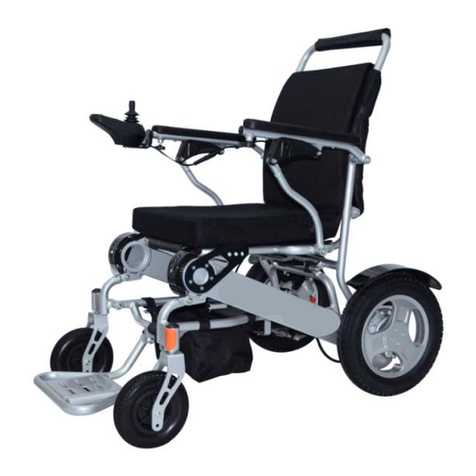
GILANI ENGINEERING
GILANI ENGINEERING GED09 User manual
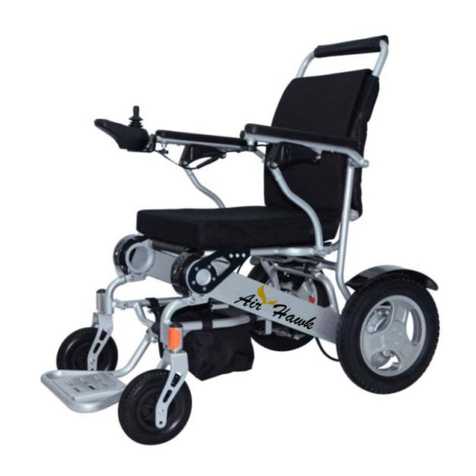
GILANI ENGINEERING
GILANI ENGINEERING Air Hawk User manual
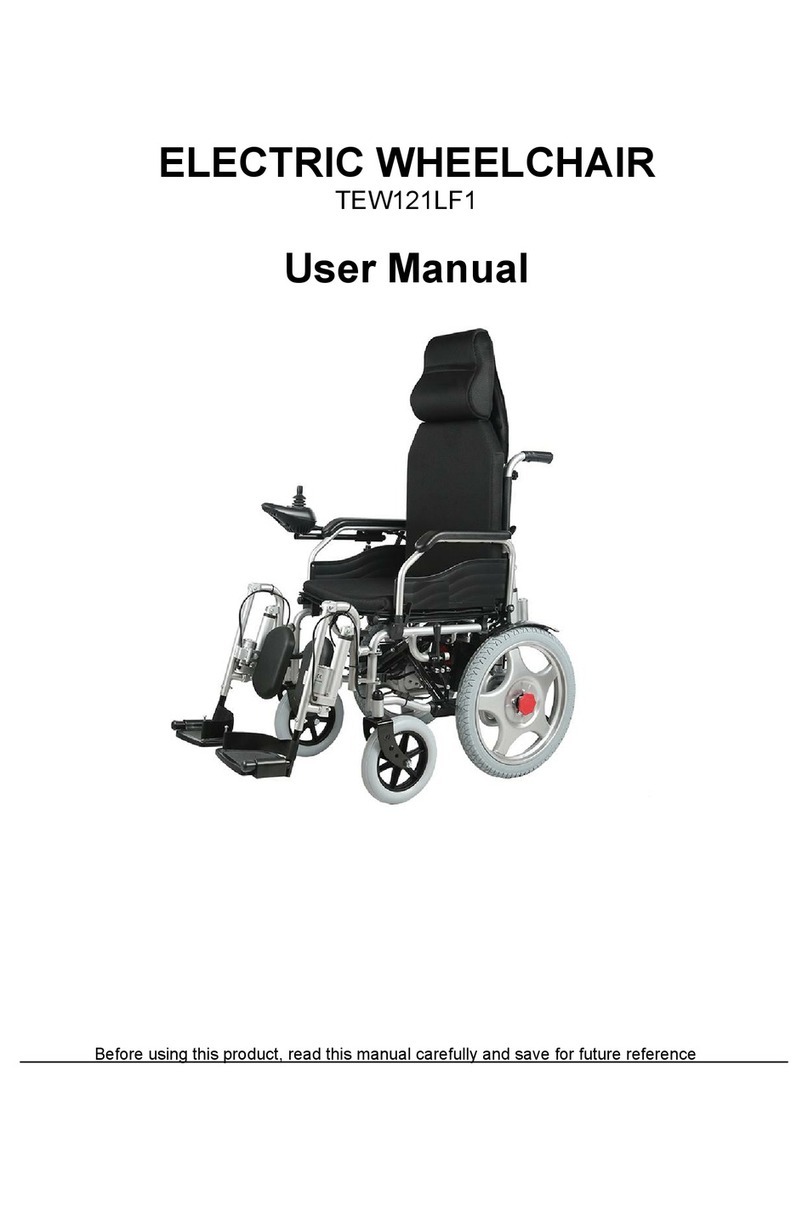
GILANI ENGINEERING
GILANI ENGINEERING TEW121LF1 User manual

GILANI ENGINEERING
GILANI ENGINEERING GED09 User manual

GILANI ENGINEERING
GILANI ENGINEERING JRWD1003 User manual
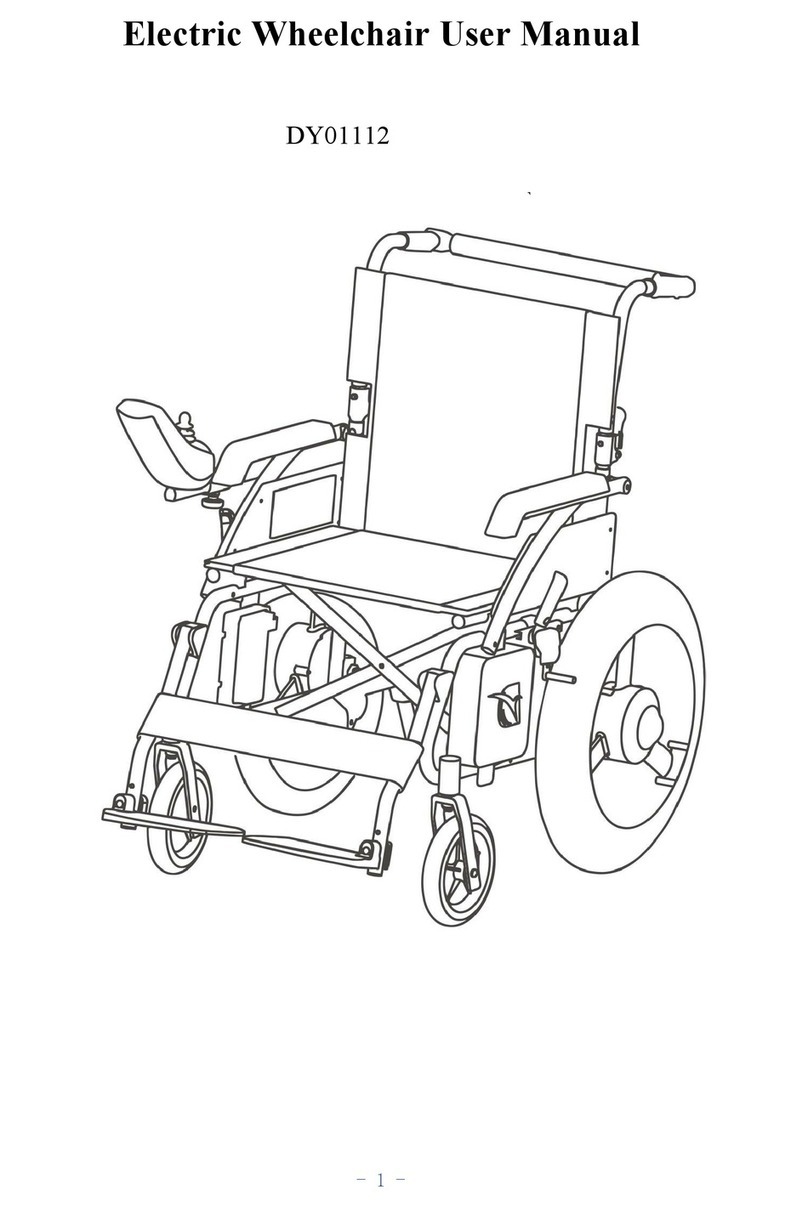
GILANI ENGINEERING
GILANI ENGINEERING DY01112 User manual
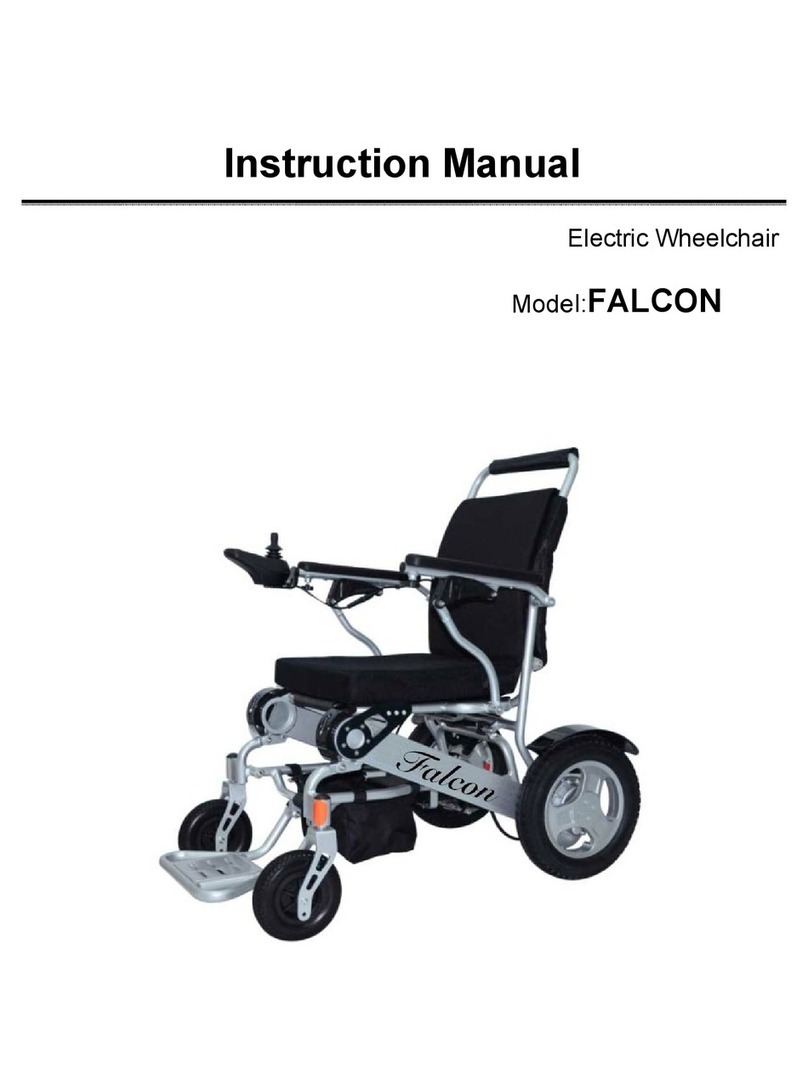
GILANI ENGINEERING
GILANI ENGINEERING FALCON User manual


